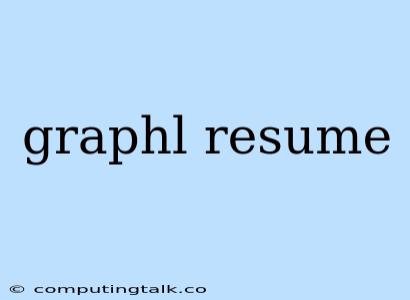Creating a Graph-Based Resume: A Modern Approach to Stand Out
In the competitive job market, making your resume stand out is crucial. Traditional resume formats, often confined to text and bullet points, can struggle to effectively showcase your skills and experience. This is where graph-based resumes come in. By leveraging the power of visual representation, graph-based resumes can offer a compelling and engaging way to highlight your qualifications and capture the attention of potential employers.
What is a Graph-Based Resume?
A graph-based resume utilizes graphical elements like charts, diagrams, and timelines to present your professional journey. It goes beyond the standard text-heavy format and allows you to visually demonstrate your skills, projects, and achievements. This approach can be particularly effective for individuals in creative fields, data-driven roles, or anyone looking to present a more dynamic and memorable resume.
Why Use a Graph-Based Resume?
Graph-based resumes offer several advantages over traditional resumes:
- Visual Appeal: They are visually appealing and engaging, capturing the attention of recruiters and employers.
- Improved Comprehension: Graphs and diagrams can make complex information easier to understand and digest.
- Better Storytelling: They allow you to tell a more compelling story about your career journey and achievements.
- Unique and Memorable: They stand out from the crowd and help you leave a lasting impression.
Types of Graphs to Consider
There are various types of graphs you can incorporate into your graph-based resume:
- Skill Trees: A skill tree can visually depict your expertise in different areas, showcasing your proficiency level in each skill.
- Timeline Charts: A timeline chart can illustrate your career progression, highlighting key milestones and achievements.
- Project Diagrams: Diagrams can showcase your involvement in specific projects, outlining your role and responsibilities.
- Network Graphs: These graphs can demonstrate your connections and collaborations with others, highlighting your professional network.
Tips for Creating a Graph-Based Resume
Here are some tips for creating an effective graph-based resume:
- Choose the Right Software: There are various software tools available to help you create graph-based resumes. Consider using tools like Adobe Illustrator, Canva, or specialized resume builders.
- Keep it Simple: Avoid using overly complex graphs that can be confusing or overwhelming.
- Focus on Relevance: Only include information that is relevant to the specific job you are applying for.
- Use Color and Design Wisely: Choose colors and design elements that are visually appealing and professional.
- Ensure Accessibility: Make sure your graph-based resume is accessible to individuals with disabilities.
- Test Print: Always test print your resume to ensure that the graphs and diagrams are clear and legible.
Examples of Graph-Based Resumes
Several online resources showcase examples of graph-based resumes, providing inspiration and ideas. Explore these resources to understand the various ways you can implement graphs in your resume.
Conclusion
Graph-based resumes offer a powerful tool for showcasing your skills and experience in a visually compelling way. By embracing this modern approach, you can create a resume that stands out from the competition and leaves a lasting impression on potential employers.
